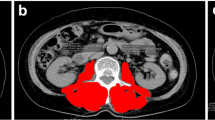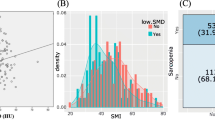Abstract
Background
Recently, numerous studies have reported an association between sarcopenia and poor outcomes in various kinds of malignancies. We investigated whether sarcopenia predicts the survival of patients with metastatic urothelial carcinoma who underwent systemic chemotherapy.
Methods
We reviewed 87 metastatic urothelial carcinoma patients who underwent chemotherapy (gemcitabine plus cisplatin or gemcitabine plus carboplatin for cisplatin-unfit patients) between 2007 and 2015. A computed tomography scan prior to chemotherapy was used for evaluating sarcopenia, and we measured three cross-sectional areas of skeletal muscle at the third lumbar vertebra and calculated the skeletal muscle index (SMI), the paraspinal muscle index (PSMI), and the total psoas area (TPA) of each patient. Predictive values of survival were assessed using Cox regression analysis.
Results
The median overall survival (OS) was 16 months (95% CI 13.5–18). Although SMI alone was not a significant predictor of shorter OS (P = 0.117) in univariate analysis, SMI stratified by the value of the body mass index (BMI) was a significant predictor of shorter OS in univariate analysis (P = 0.037) and was also an independent predictor of shorter OS in multivariate analysis (P = 0.026). PSMI and TPA were not significant prognostic factors even when stratified by BMI (P = 0.294 and 0.448), respectively.
Conclusion
Neither PSMI nor TPA could substitute SMI as a predictor for poor outcomes in metastatic urothelial carcinoma patients treated with systemic chemotherapy in our study. SMI stratified by BMI is a useful predictor of prognosis in these patients.




Similar content being viewed by others
Abbreviations
- GC:
-
Gemcitabine plus cisplatin
- GCb:
-
Gemcitabine plus carboplatin
- CT:
-
Computed tomography
- SMI:
-
Skeletal muscle index
- PSMI:
-
Paraspinal muscle index
- TPA:
-
Total psoas area
- OS:
-
Overall survival
- CI:
-
Confidence interval
- BMI:
-
Body mass index
- EWGSOP:
-
European Working Group on Sarcopenia in Older People
- UC:
-
Urothelial carcinoma
- MVAC:
-
Methotrexate, vinblastine, doxorubicin and cisplatin
- mUC:
-
Metastatic urothelial carcinoma
- ECOG PS:
-
Eastern Cooperative Oncology Group performance status
- LVI:
-
Lymphovascular invasion
- CRP:
-
C-reactive protein
- GPS:
-
Glasgow prognostic score
- L3:
-
Third lumber vertebra
- IQR:
-
Interquartile range
- DXA:
-
Dual-energy X-ray absorptiometry
- CT:
-
Computed tomography
- MRI:
-
Magnetic resonance imaging
- CVD:
-
Cardiovascular disease
References
Rosenberg IH (1997) Sarcopenia: origins and clinical relevance. J Nutr 127(5 Suppl):990S–991S
Cruz-Jentoft AJ, Baeyens JP, Bauer JM et al (2010) Sarcopenia: European consensus on definition and diagnosis: Report of the European Working Group on Sarcopenia in older people. Age Ageing 39(4):412–423
Psutka SP, Carrasco A, Schmit GD et al (2014) Sarcopenia in patients with bladder cancer undergoing radical cystectomy: impact on cancer-specific and all-cause mortality. Cancer 120(18):2910–2918
Peng P, Hyder O, Firoozmand A et al (2012) Impact of sarcopenia on outcomes following resection of pancreatic adenocarcinoma. J Gastrointest Surg 16(8):1478–1486
Fukushima H, Nakanishi Y, Kataoka M et al (2016) Prognostic significance of sarcopenia in patients with metastatic renal cell carcinoma. J Urol 195(1):26–32
Huillard O, Mir O, Peyromaure M et al (2013) Sarcopenia and body mass index predict sunitinib-induced early dose-limiting toxicities in renal cancer patients. Br J Cancer 108(5):1034–1041
Antoun S, Baracos VE, Birdsell L et al (2010) Low body mass index and sarcopenia associated with dose-limiting toxicity of sorafenib in patients with renal cell carcinoma. Ann Oncol 21(8):1594–1598
Lieffers JR, Bathe OF, Fassbender K et al (2012) Sarcopenia is associated with postoperative infection and delayed recovery from colorectal cancer resection surgery. Br J Cancer 107(6):931–936
Smith AB, Deal AM, Yu H et al (2014) Sarcopenia as a predictor of complications and survival following radical cystectomy. J Urol 191(6):1714–1720
Hori M, Matsuda T, Shibata A et al (2015) Cancer incidence and incidence rates in Japan in 2009: a study of 32 population-based cancer registries for the Monitoring of Cancer Incidence in Japan (MCIJ) project. Jpn J Clin Oncol 45(9):884–891
von der Maase H, Sengelov L, Roberts JT et al (2005) Long-term survival results of a randomized trial comparing gemcitabine plus cisplatin, with methotrexate, vinblastine, doxorubicin, plus cisplatin in patients with bladder cancer. J Clin Oncol 23(21):4602–4608
Galsky MD, Hahn NM, Rosenberg J et al (2011) Treatment of patients with metastatic urothelial cancer “unfit” for Cisplatin-based chemotherapy. J Clin Oncol 29(17):2432–2438
Fukushima H, Yokoyama M, Nakanishi Y et al (2015) Sarcopenia as a prognostic biomarker of advanced urothelial carcinoma. PLoS One 10(1):e0115895. https://doi.org/10.1371/journal.pone.0115895
Fearon K, Strasser F, Anker SD et al (2011) Definition and classification of cancer cachexia: an international consensus. Lancet Oncol 12(5):489–495
Kanda Y (2013) Investigation of the freely available easy-to-use software ‘EZR’ for medical statistics. Bone Marrow Transplant 48(3):452–458
Shen W, Punyanitya M, Wang Z et al (2004) Total body skeletal muscle and adipose tissue volumes: estimation from a single abdominal cross-sectional image. J Appl Physiol 97(6):2333–2338
Mourtzakis M, Prado CM, Lieffers JR et al (2008) A practical and precise approach to quantification of body composition in cancer patients using computed tomography images acquired during routine care. Appl Physiol Nutr Metab 33(5):997–1006
Fortin M, Battie MC (2012) Quantitative paraspinal muscle measurements: inter-software reliability and agreement using OsiriX and ImageJ. Phys Ther 92(6):853–864
Peng PD, van Vledder MG, Tsai S et al (2011) Sarcopenia negatively impacts short-term outcomes in patients undergoing hepatic resection for colorectal liver metastasis. HPB 13(7):439–446
Taguchi S, Akamatsu N, Nakagawa T et al (2016) Sarcopenia evaluated using the skeletal muscle index is a significant prognostic factor for metastatic urothelial carcinoma. Clin Genitourin Cancer 14(3):237–243
Amini N, Spolverato G, Gupta R et al (2015) Impact total psoas volume on short- and long-term outcomes in patients undergoing curative resection for pancreatic adenocarcinoma: a new tool to assess sarcopenia. J Gastrointest Surg 19(9):1593–1602
Angeras O, Albertsson P, Karason K et al (2013) Evidence for obesity paradox in patients with acute coronary syndromes: a report from the Swedish Coronary Angiography and Angioplasty Registry. Eur Heart J 34(5):345–353
Gonzalez MC, Pastore CA, Orlandi SP et al (2014) Obesity paradox in cancer: new insights provided by body composition. Am J Clin Nutr 99(5):999–1005
Caan BJ, Meyerhardt JA, Kroenke CH et al (2017) Explaining the obesity paradox: the association between body composition and colorectal cancer survival (C-SCANS Study). Cancer Epidemiol Biomarkers Prev. https://doi.org/10.1158/1055-9965.EPI-17-0200
Wannamethee SG, Atkins JL (2015) Muscle loss and obesity: the health implications of sarcopenia and sarcopenic obesity. Proc Nutr Soc 74(4):405–412
Prado CM, Lieffers JR, McCargar LJ et al (2008) Prevalence and clinical implications of sarcopenic obesity in patients with solid tumours of the respiratory and gastrointestinal tracts: a population-based study. Lancet Oncol 9(7):629–635
Palmela C, Velho S, Agostinho L et al (2017) Body composition as a prognostic factor of neoadjuvant chemotherapy toxicity and outcome in patients with locally advanced gastric cancer. J Gastric Cancer 17(1):74–87
Hall DT, Ma JF, Marco SD et al (2011) Inducible nitric oxide synthase (iNOS) in muscle wasting syndrome, sarcopenia, and cachexia. Aging 3(8):702–715
Friedenreich CM, Wang Q, Neilson HK et al (2016) Physical activity and survival after prostate cancer. Eur Urol 70(4):576–585
Acknowledgements
The authors are grateful to Dr. Ken-Ichiro Yoshida and Dr. Kyoko Arai for constructive suggestions, ServiceScape (https://www.servicescape.com) and Jessica McHale (http://oe-boston.com) for English language editing.
Author information
Authors and Affiliations
Corresponding author
Ethics declarations
Conflict of interest
All authors have no conflict of interest to declare.
About this article
Cite this article
Abe, H., Takei, K., Uematsu, T. et al. Significance of sarcopenia as a prognostic factor for metastatic urothelial carcinoma patients treated with systemic chemotherapy. Int J Clin Oncol 23, 338–346 (2018). https://doi.org/10.1007/s10147-017-1207-x
Received:
Accepted:
Published:
Issue Date:
DOI: https://doi.org/10.1007/s10147-017-1207-x




